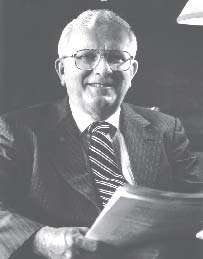EPILOGUE
There comes a time in our lives when we meet people who are outstanding individuals. What they exude is a certain simplicity and honesty, and a complete lack of braggadocio. They are aware of their own shortcomings.
When it comes to a choice between their own needs and the needs of others, they place the others first. It is refreshing to meet such people. The stories within this book are the memoirs of a unique person and his ever loyal wife. It was her strength and love that formed the basis for his survival. Within these pages the personalities of Bub and Treg emerge as both ordinary and heroic.
The Merrills are in the autumn of their lives. Yet, that same spirit that kept their hopes alive during the almost hopeless years of Japanese imprisonment, still prevails today. Illness has become a daily companion.
Yet, when you are with them, their love for one another cannot be hidden. I doubt seriously that death will end their love. Bub still addresses Treg as Dear. Treg refers to Bub as her one and only love. Impatience is a malady of the aged. Flair-ups happen, but they are always followed by a thinly veiled apology. One great element of their friendship is the humor that goes back and forth between the two of them. I would sometimes drop in unannounced. I would ask Treg, “Where is Bub” She would answer, “I don’t know....haven’t seen him in years.
Or I would ask Bub, “How’s Treg feeling today?” He would answer, “She doesn’t have any! Each time a different set of replies would be forthcoming. Sometimes, I would “pop” in and ask “ Am I on time for lunch?”
Treg would shout out, “No, but I will change clothes and be ready in a minute! Their good sense of humor simple pervaded their lives.
The brutality of the Japanese during WW2 has always been somewhat a mystery. In conversations with Bub, it became clear that he understood the problem. To him the war with Japan was a clash of cultures. Their traditions of Samurai and Banzai completely colored their military behavior. Bub often said that the Japanese officers were equally brutal toward their own soldiers as the were toward the American prisoners. The most disconcerting part of Bub’s experience was the total unpredictably of any given Japanese at any given time.
They were simply arbitrary. On many occasions, the Japanese could be both brutal and merciful. To this day Bub does not understand this ambiguity.
(Return to Contents)
APPENDICES
World War II was a war of devastation. The following official reports are indicative of the destruction.
Germany was a brutal force against humanity, especially in the Holocaust. Japan was equally brutal in the annihilation of Peking and Manila. The treatment of prisoners of war by the Japanese was simply horrific.
Today, Germany and Japan are stabilizing forces in the struggle for global peace.
The following appendices are not meant to demean the Japanese. They are meant to remind mankind as to the depths of degradation to which some nations had fallen. We as a nation must be careful not to allow such atrocities to be committed again either by ourselves or by others. The appendices are as follows:
(Return to Contents)
CAMP O’DONNELL REPORT
AMERICAN PRISONERS OF WAR INTERNED BY THE JAPANESE IN THE PHILIPPINES.
Prepared by the Office of Provost Marshall General,19 November, 1945.
Summarized:
Once arrived on the area at San Fernando, the prisoners were crowded into boxcars and taken to Camp O’Donnell, located near Capas in North Luzon Because of the starvation, disease, and brutal treatment they received, 2,000 Americans and 22,000 Filipino prisoners died at Camp O’Donnell. Eye witness reports Excerpts:
Corporal Arthur A. Chenowith.....Although the Japanese had plenty of food and medicine, 1600 Americans and 20,000+ Filipinos died of disease and starvation. Captain Mark M. Wohfeld...........Lacked cooking water.
Water from a murky creek two miles away had to by carried in oil drums on bamboo poles. For drinking water, prisoners had to stand the better part of the days to reach three spigots in the center of the camp. Salt and sweet potato were added to the rice diet. Most could not eat because of malaria and dysentery. The sick lay on floors in a so called hospital Covered with feces, blood vomit and flies. Major William E. Dyess............We were marched for several days without water or food. We were made to sit in the boiling sun during the day and not permitted to lie down at night. Prisoners who fell out of line because of sickness were killed on the spot. Several were buries alive. The prisoners were terrorized and dehumanized. During the first week at O’Donnell, twenty men a day perished. During the second week the numbers rose to fifty a day. Regardless of their weakened condition, the prisoners were forced into work details. The great sadness was to see the prisoners die as they buried their dead.
CABANATUAN
Report On American Prisoners of War Interned by the Japanese in the Philippines. Prepared by the Office Of The Provost Marshall General, 19 November, 1945 There were several interment camps at Cabanatuan. The camps were twelve miles from the town of Cabanatuan. Camp # 1 held the relatively healthy prisoners who surrendered at Corregidor. Camp #2 held the prisoners from Bataan and other parts of the Philippines. Camp # 3
served as a makeshift hospital. The very ill from camps #1 and #2 were sent to Camp 3. It was a death camp and the burial details were from camps #1 and #2. These camps were administered far better than Camp O’Donnell.
The death rate at Camps two and three was greater than that of Camp one. The high death rate was due to starvation, dysentery, scurvy, malaria, and beriberi. The officers of the Camps organized the camps into administration, kitchens, and dispensaries. There were medical doctors dentists and medical corpsmen among the prisoners, but they had very little drugs to work with. It should be noted that the large number of deaths at these camps was also due to the cut in rations prior to surrender. The fighting men had their rations cut to one eighth of the ordinary daily rations. Consequently, both the prisoners from Bataan and Corregidor were in vary poor health at the time of capture.
HOTEN POW MAIN CAMP MUKDEN, MANCHURIA
Report by: Capt. James I Norwood
Capt. Emily L Shek
31 July 1946
Summarized:
Hoten was the name of the POW camp on the outskirts of Mukden, Manchuria, ( Shenyang, China ) three miles northeast of the walled city. The camp was several miles from the industrial part of the city which housed the Japanese MKK factories. These factories manufactured airplane parts, structural steel, and tannery goods.
The camp held prisoners from Bataan,Corregidor,and Singapore. There were three brick buildings for housing, very similar to Japanese Barracks. The men slept on raised wooden platforms with a straw mattress beneath them. The rooms were heated by two small stoves which were inadequate to ward off the 20 below zero outside temperatures. In a separate building there were 22 showers and three pools. This facility was not heated.
Another brick building was used as a cookhouse and bakery. The prisoners did the cooking and baking under Japanese supervision. It was then carried in large buckets to the barracks where it was distributed to the prisoners.The food was the same every day. Breakfast consisted of corn mush. Supper and dinner was a watery vegetable soup and a bun. The vegetables were grown by the prisoners on a plot of land next to the barracks.
The vegetables were varied and in good supply. The prisoners were marched to the factories every day except Sunday. On Sunday and holidays, the prisoners could play sports on an open field next to the barracks. YMCA had provided over 1000 books for a small library.
LIST OF PRISONERS LIBERATED
The Russian Red Army Guard was under the command of Colonel Skriknikov. He and Colonel Pilet of the American Army jointly created a list of prisoners at Hoten. The document was signed by the above officers. On August 10 and 11 of 1945, a list of 1,383 officers and soldiers of the allied forces was made by the Russians and Americans. Gradually the men were released from the camp. The less ill were transported by rail to Dairen(Luda, China). The very ill were flown to their respective military centers. On August 24, 1945, 47
former prisoners were airlifted out of Camp Hoten. This included officers and soldiers. On August 27, 1945, thirty officers and men were airlifted. Among these were Lt. General J.M. Wainwright who surrendered Corregidor in 1942 and Major General E.P.King who surrendered Bataan in 1942. On 30 August, 14 were evacuated. On the same day 47 other men departed but a record of there names is not available.On September 4,1945 another 37 were airlifted. On 2 and 10 September, 23 men were airlifted. Beginning September 11, 1945, 44 officers and 587 enlisted men were sent by train to Korea to board hospital ships. On this list, the name of Corporal Smith Merrill # 36115779 of the Corps of Engineers ( the subject of Silence Of A Soldier) appeared.
THE DESTRUCTION OF MANILA
The account of the destruction of Manila is based on testimony collected from eye- witnesses by the US
forces which liberated Manila. The testimony was under oath. The reports are condensed. The once proud city of Manila is dead. The churches, convents, schools and universities have been reduced to rubble by the Japanese.The civilian population has been starved, raped, burned, murdered, mutilated and bayoneted, including small infants.The orders for these atrocities came directly from Tokyo. The destruction of Manila was not the act of crazed troops. It was a operation carefully planned by General Yamashita and the Japanese high command.
Excerpts:
In the first three weeks of February,1945, The Japanese began to destroy methodically the churches, convents and charitable institutions in the inner city (Intramuros) St. Tomas University, the Manila Cathedral, hospitals and libraries were either bombed or set ablaze. The occupants of these institutions were locked inside the buildings when they were set afire. Orphans, foundlings, sick people in hospitals and insane people in the Asylums were locked into their institutions to be burned to death along with the incinerated buildings. On January 25, 1945, Japanese soldiered entered the facility of the Philippine Red Cross.They bayoneted or shot doctors, nurses, babies with their mothers, young girls, some of whom they raped. On February 12, they entered Lasalle College. There were seventy people within the premises. The inhabitants were slain with sabers, bayoneted, or shot. On February 23, 1945, in one charitable institution, 50 people were shot in the head with their hands tied behind their backs. A few blocks away another 30 bodies suffered the same fate. On February 24,1945, an air-tight food vault was opened to reveal the bodies of close to 300 people suffocated in the cramped 15 by 18 foot space. The Spanish Consulate flying the Spanish flag was set afire killing more than fifty people within. Filipinos in the outlying areas faired no better. In Calamba, 5000 men, women and children were slaughtered and the town decimated. At the Medical School of the University of the Philippines 190 students and faculty were locked into one room in which the furniture had been soaked with gasoline. The doors were locked and the room set afire. Only three people survived. Dr. Frankel a university surgeon lived to tell the terrible story. Captured Japanese documents record the death of 1000 civilians. Men were shot after their genitals had been cut of. Women were mutilated by having their breast slashed off with sabers. Children were bayoneted. Area by area, block by block homes and buildings were torched. Whole neighborhoods disappeared.
These are only a few of the evils perpetrated on the Filipinos by the Japanese As the war drew to an end, the Japanese forces took their revenge on the defenseless civilian population. When they were finished, Manila had been leveled. The people lay dead everywhere, in the streets, in the buildings in the schools and in the churches.

William J. Duggan retired from Webster University, St. Louis, Missouri, 1995, as Provost of the University.
He was at Webster close to thirty years: first as a professor of Comparative Religion; then as Dean of the Graduate School. He established Graduate Studies programs in: Geneva Switzerland; Vienna, Austria; Leiden, The Netherlands, and London, England. He also established Graduate Studies at some thirty seven military bases across the United States.
William and his wife Barbara divide their time between the Charleston SC area and Petoskey, Michigan. As Professor of Comparative Religion, Duggan wrote "Myth And Christian Belief" Fides Press (1970) which traced the influences of Babylonian and Jewish religious thought on early Christianity. During the 90's He has published many commentaries in the form of Political Satire. His interests are reading, writing, and not arithmatic, but golf.
###








